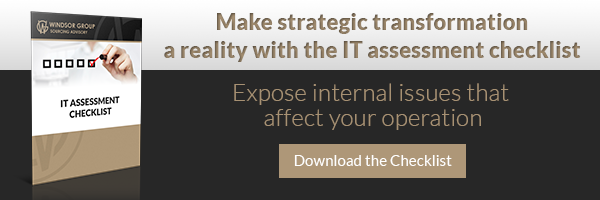 Developing an IT infrastructure assessment checklist is an absolute necessity if you’re considering any type of outsourcing. It’s the only way to assure you’re comparing apples to apples when it comes to potential service delivery solutions and providers, and it’s the only way to assure you’re comparing true total cost of ownership.
Developing an IT infrastructure assessment checklist is an absolute necessity if you’re considering any type of outsourcing. It’s the only way to assure you’re comparing apples to apples when it comes to potential service delivery solutions and providers, and it’s the only way to assure you’re comparing true total cost of ownership.
But a comprehensive, well-thought-out IT infrastructure assessment checklist also comes in handy as an ongoing business review tool. Incorporating it into your annual planning process will help you stay on your toes, rather than making possibly faulty assumptions about your ongoing capabilities. And at the rate IT technology and practices are changing, you can’t afford to view assessment as a one-time, “we already did that” exercise.
So what should your checklist cover? A lot more than just the physical “stuff” you might associate with IT infrastructure. It has to give you holistic insight into your company’s ability to function electronically. And that means considering both service outputs and costs as well as physical equipment. Get your own IT checklist here for free.
Financial data.
Your checklist should identify IT operations costs for each service area, plus all the other expenses that make up your IT total cost of ownership. That includes expenses that are allocated to non-IT budget lines -- HR, facilities management labor and overhead, etc. -- as well as indirect costs such as data center and other facilities costs, depreciation and amortization. Think broadly, and don’t omit anything.
Hardware and software.
List what you now have in the way of equipment and related storage and computing capacity as well as enterprise or third-party applications you’re currently using. How old are your legacy systems?
Cultural “specifications.”
Your IT infrastructure assessment checklist should consider specific internal issues or desires that affect the way you use IT or potential sourcing decisions.
Remember that service quality issues such as availability and reliability have an intangible effect beyond what you can quantify. They have the power to create and maintain a positive attitude among employees and also clients and customers that interact with you electronically. Customer-centric considerations are ever more important to build satisfaction and loyalty in today’s unpredictable economy.
Staffing.
List your current staff and their status – who’s about to retire, etc. Are you short on key skills? Are you already having hiring troubles?
Performance.
List what you’re currently doing well and what services you currently deliver, but not well.
What do you need now but aren’t able to provide? What will you need to meet future goals that you don’t currently have? List what’s needed to implement specific new initiatives and also what you’ll need to give your organization a functional cushion – some “competitive leeway,” if you will. Think flexibility and scalability.
If you’re considering widespread internal or outsourcing-based transformation or even comparatively smaller changes, what will you need to effect a smooth, cost-effective transition?
Governance.
Your IT infrastructure assessment checklist should address current policies and procedures. Do yours support appropriate levels of security as well as agile decision-making? Are you prepared to incorporate new technologies and practices, for instance the growing prevalence of all types of mobile devices and the challenges brought about by increasing employee preference for BYOD? List each of these specific challenges your enterprise faces. (Get your own IT checklist here for free).
Risk management.
How exposed are you right now, both physical facilities and/or data? Is your disaster recovery plan adequate to meet compliance regulations and assure you can maintain or quickly restore continuity if something catastrophic happens?
Corporate goals and short-term implementation benchmarks.
While these aren’t actually part of your IT infrastructure assessment checklist, they comprise the necessary companion piece. You cannot evaluate and diagnose anything without benchmarks, and your assessment will only be effective if it considers both “what we have” and “what’s the effect of that on our organization?”
The more thorough you are developing your assessment checklist, the more valuable it will be.
Photo credit: PNASH via Flick


